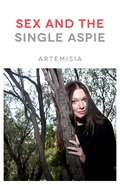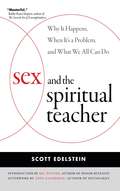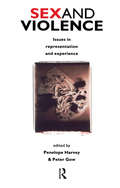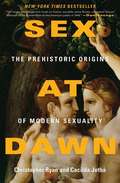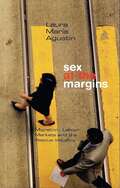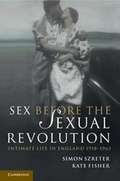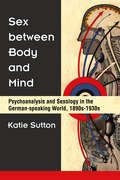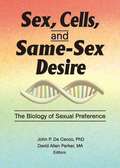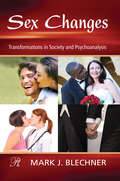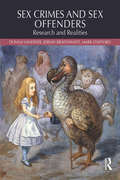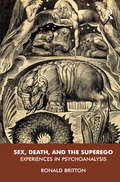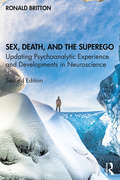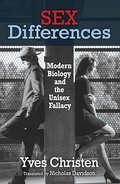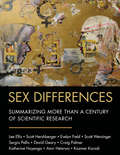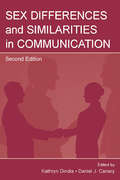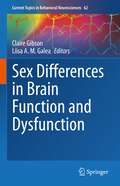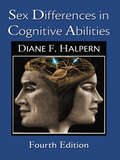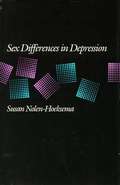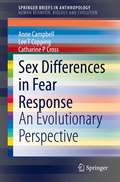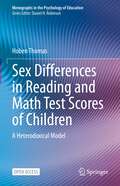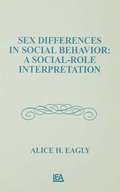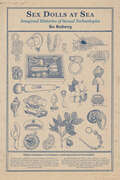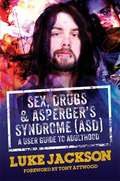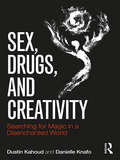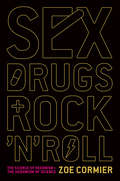- Table View
- List View
Sex and the Single Aspie
by ArtemisiaThis ground-breaking book about sexuality speaks to women on the autism spectrum in fresh new ways, opening doors to discussion, and blowing the lid off taboo subjects. One of the many problems women on the spectrum face is not always understanding how relationships and boundaries work for other people. This book provides answers, plus more that they may not even have thought to ask. Covering one night stands, the importance of safe sex, self-respect, and double standards, there is a wealth of information about the ethics and self-understanding involved in relationships. Written with humour and honesty, this is the go-to guide for sex on the spectrum.
Sex and the Spiritual Teacher
by Scott Edelstein Anne Katherine Mic HunterSex and the Spiritual Teacher looks at the complex of forces that tempt otherwise insightful, compassionate, and well-intentioned teachers to lose their way--and that tempt some of their students to lose their way as well. It analyzes why most of our current efforts to keep spiritual teachers from transgressing usually don't (and in fact can't) work. Perhaps most importantly, it suggests a set of practices and structures that can build community, encourage healthy student-teacher relationships, increase trust and spiritual intimacy between teachers and their students, and help authentic spiritual teachers stay happily monogamous or celibate. Sex and the Spiritual Teacher is for anyone who is or might become part of a spiritual community: students, teachers, clergy, lay leaders, and even casual visitors. It's a reader-friendly, no-nonsense guide to making spiritual life safer and fuller for all of us one person, relationship, and community at a time.
Sex and Violence: The Psychology of Violence and Risk Assessment
by Penelope HarveyProduced in response to the growing international demand for information, this book details the latest research in understanding and controlling violent and sexual offences. Increasing numbers of psychologists are now studying and working with offenders to the advancement of forensic psychology.Chapters cover contributions from ten different countries and are grouped into three sections dealing with risk assessment, sex offenders and offences and violent offenders and offences. The first section discusses the progress that has been made towards making accurate decisions about the risk that an individual poses to the community and emphasises the need to draw on both clinical experience and research.The second section explores understandings and investigations of sexual offences including discussion on: American commitment laws for sexually violent predators; the status of "recovered memories" in criminal trials; factors influencing delays in reporting sexual abuse; a model of rapists' accounts of their offences; and situational factors in sexual offending.The final section on violent offenders and offences includes discussion on: criminal careers; domestic violence; mutiliation-murder in Japan; offender profiling; and sentencing of homicide cases.This book will be of interest to scholars in criminology, psychology and forensic psychiatry and to policy-makers and practitioners who deal with sexual and violent offences.
Sex at Dawn: The Prehistoric Origins of Modern Sexuality
by Christopher Ryan Cacilda JetháSince Darwin's day, we've been told that sexual monogamy comes naturally to our species. Mainstream science--as well as religious and cultural institutions--has maintained that men and women evolved in families in which a man's possessions and protection were exchanged for a woman's fertility and fidelity. But this narrative is collapsing. Fewer and fewer couples are getting married, and divorce rates keep climbing as adultery and flagging libido drag down even seemingly solid marriages. How can reality be reconciled with the accepted narrative? It can't be, according to renegade thinkers Christopher Ryan and Cacilda Jethå. While debunking almost everything we "know" about sex, they offer a bold alternative explanation in this provocative and brilliant book. Ryan and Jethå's central contention is that human beings evolved in egalitarian groups that shared food, child care, and, often, sexual partners. Weaving together convergent, frequently overlooked evidence from anthropology, archaeology, primatology, anatomy, and psychosexuality, the authors show how far from human nature monogamy really is. Human beings everywhere and in every era have confronted the same familiar, intimate situations in surprisingly different ways. The authors expose the ancient roots of human sexuality while pointing toward a more optimistic future illuminated by our innate capacities for love, cooperation, and generosity. With intelligence, humor, and wonder, Ryan and Jethå show how our promiscuous past haunts our struggles over monogamy, sexual orientation, and family dynamics. They explore why long-term fidelity can be so difficult for so many; why sexual passion tends to fade even as love deepens; why many middle-aged men risk everything for transient affairs with younger women; why homosexuality persists in the face of standard evolutionary logic; and what the human body reveals about the prehistoric origins of modern sexuality. In the tradition of the best historical and scientific writing, Sex at Dawn unapologetically upends unwarranted assumptions and unfounded conclusions while offering a revolutionary understanding of why we live and love as we do.
Sex at the Margins
by Laura María AgustinThis groundbreaking book explodes several myths: that selling sex is completely different from any other kind of work; that migrants who sell sex are passive victims; and that the multitude of people out to save them are without self-interest. <p><p> Laura Agustín makes a passionate case against these stereotypes, arguing that the label 'trafficked' does not accurately describe migrants' lives and that the 'rescue industry' disempowers them. Based on extensive research amongst migrants who sell sex and social helpers, Sex at the Margins provides a radically different analysis. Frequently, says Agustín, migrants make rational choices to travel and work in the sex industry. Although they are treated like a marginalised group they form part of the dynamic global economy. <p> Both powerful and controversial, this book is essential reading for all those who want to understand the increasingly important relationship between sex markets, migration and the desire for social justice.
Sex Before the Sexual Revolution: Intimate Life In England, 1918-1963
by Simon Szreter Kate FisherWhat did sex mean for ordinary people before the sexual revolution of the 1960s and 1970s, who were often pitied by later generations as repressed, unfulfilled and full of moral anxiety? This book provides the first rounded, first-hand account of sexuality in marriage in the early and mid-twentieth century. These award-winning authors look beyond conventions of silence among the respectable majority to challenge stereotypes of ignorance and inhibition. Based on vivid, compelling and frank testimonies from a socially and geographically diverse range of individuals, the book explores a spectrum of sexual experiences, from learning about sex and sexual practices in courtship, to attitudes to the body, marital ideals and birth control. It demonstrates that while the era's emphasis on silence and strict moral codes could for some be a source of inhibition and dissatisfaction, for many the culture of privacy and innocence was central to fulfilling and pleasurable intimate lives.
Sex between Body and Mind: Psychoanalysis and Sexology in the German-speaking World, 1890s-1930s (Social History, Popular Culture, And Politics In Germany)
by Katie SuttonIdeas about human sexuality and sexual development changed dramatically across the first half of the 20th century. As scholars such as Magnus Hirschfeld, Iwan Bloch, Albert Moll, and Karen Horney in Berlin and Sigmund Freud, Wilhelm Stekel, and Helene Deutsch in Vienna were recognized as leaders in their fields, the German-speaking world quickly became the international center of medical-scientific sex research—and the birthplace of two new and distinct professional disciplines, sexology and psychoanalysis. This is the first book to closely examine vital encounters among this era’s German-speaking researchers across their emerging professional and disciplinary boundaries. Although psychoanalysis was often considered part of a broader “sexual science,” sexologists increasingly distanced themselves from its mysterious concepts and clinical methods. Instead, they turned to more pragmatic, interventionist therapies—in particular, to the burgeoning field of hormone research, which they saw as crucial to establishing their own professional relevance. As sexology and psychoanalysis diverged, heated debates arose around concerns such as the sexual life of the child, the origins and treatment of homosexuality and transgender phenomena, and female frigidity. This new story of the emergence of two separate approaches to the study of sex demonstrates that the distinctions between them were always part of a dialogic and competitive process. It fundamentally revises our understanding of the production of modern sexual subjects.
Sex, Cells, and Same-Sex Desire: The Biology of Sexual Preference
by David A ParkerThis fascinating new book explores the myriad aspects of biological theories of sexual preference. Sex, Cells, and Same-Sex Desire describes, reviews, and questions recent biological research on sexual preference from the point of view of knowledgeable scientists and of scholars in the social sciences and humanities representing the emerging field of gay studies. The issues involved have a vibrant history, are wide-ranging, and remain the objects of much controversy. This book demystifies biological research on sexual preference and makes it accessible to readers unfamiliar with biological and medical research.Sex, Cells, and Same-Sex Desire is divided into several sections, each of which is introduced by an explanation of key concepts and terms found in that section. The book begins with a discussion of the history of biological theories and sociocultural concepts of gender and sexuality. The next 3 sections explore specialized areas of biological science and related issues: genetics and evaluation, hormones and the endocrine system, and brain physiology and structure. A final section discusses social stigma, science, and medicine. A glossary of terms used by the authors is included, so readers may look up those that may be unfamiliar.
Sex Changes: Transformations in Society and Psychoanalysis (Psychoanalysis in a New Key Book Series)
by Mark J. BlechnerThe last half-century has seen enormous changes in society’s attitude toward sexuality. In the 1950s, homosexuals in the United States were routinely arrested; today, homosexual activity between consenting adults is legal in every state, with same-sex marriage legal in Massachusetts and Connecticut. In the 1950s, ambitious women were often seen as psychopathological and were told by psychoanalysts that they had penis envy that needed treatment; today, a woman has campaigned for President of the United States. Mark Blechner has lived and worked through these startling changes in society, and Sex Changes collects papers he has written over the last 45 years on sex, gender, and sexuality. Interspersed with these papers are reflections on the changes that have occurred during that time period, both within the scope of society at large as well as in his personal experiences inside and outside of the therapeutic setting. He shows how changes in society, changes in his life, and changes in his writing on sexuality - as well as changes within psychoanalysis itself - have affected one another. One hundred years ago, psychoanalysis was at the cutting edge of new ideas about sex and gender, but in the latter half of the 20th Century, psychoanalysts were often seen as reactionary upholders of society’s prejudices. Sex Changes seeks to restore the place of psychoanalysis as the "once and future queer science," and aims for a radical shift in psychoanalytic thinking about sexuality, gender, normalcy, prejudice, and the relationship of therapeutic aims and values.
Sex Crimes and Sex Offenders: Research and Realities
by Donna Vandiver Jeremy Braithwaite Mark Stafford<p>Sex Crimes and Sex Offenders: Research and Realities provides an overview of social scientific theory and research on sex crimes and sex offenders. Most other books on the market are focused on a single issue—such as treatment, rape, pedophilia, theory, etc. This book is unique in that it covers the most current theory and research along with individual cases of sex crimes (e.g., Kobe Bryant, Jerry Sandusky, and other case studies), effectively linking theory and research with the realities of sex crimes and sex offenders as well as their victims. <p>Vandiver, Braithwaite, and Stafford are careful to dispel myths and to focus on the heterogeneity of sex crimes and sex offenders, and not on any one issue or population or theory. Instead, they weave a framework using a full range of theoretical concepts and research data to integrate their discussions of crimes, offenders, victims, treatments, and policy implications. The result is a valuable resource for students and early-stage researchers investigating sex crimes or offenders.</p>
Sex, Death, and the Superego: Experiences in Psychoanalysis
by Ronald BrittonThis book is a personal reappraisal of psychoanalytic theories in the light of clinical experience. The first part is about sexuality and begins where psychoanalysis began, with hysteria. The second part is about the ego and the super-ego, the relationship of which dominated Freud's writing from his middle period onwards. The last part is on narcissism and the narcissistic disorders, a major preoccupation of psychoanalysis in the second half of the twentieth century.
Sex, Death, and the Superego: Updating Psychoanalytic Experience and Developments in Neuroscience
by Ronald BrittonThis second edition of Ronald Britton’s personal reappraisal of psychoanalytic theories is based on further clinical experience, further study of current neuroscience and continued reflection on the relationship of brain and mind, selfhood and self-awareness, belief and knowledge, and certainty and uncertainty. Divided into three parts – "Hysteria," "The ego and superego," and "Narcissism" – this new edition adds content on brain, mind and self, the death instinct and a discussion on the biological, psychological and sociological basis of gender. It suggests that our increasing knowledge necessarily produces a dissolution of our coherent concepts of mind and brain, and that during this phase of creative dissolution we need to reassess what we know and what we don’t know. Fundamental to the book is the notion that human beings have to live with probability but that we long for certainty, and create it for ourselves. This book will be of great interest to psychoanalysts in clinical practice and academia, as well as other mental health professionals and those with an interest in psychoanalytic theory.
Sex Differences: Modern Biology and the Unisex Fallacy (Research And Perspectives In Endocrine Interactions Ser.)
by Yves Christen Nicholas DavidsonFew people realize how much science can tell us about the differences between men and women. Yves Christen, provided the first comprehensive overview of research in this area when this classic book was first published in the1990s. He goes beyond simplistic biology is destiny arguments and constructs a convincing case for linking social and biological approaches in order to understand complex differences in behavior.Biologists agree that the sexes differ in brain and body structure. Christen links these differences in cerebral anatomy to differences in behavior and intellect. Taking his readers on a journey through psychology, endocrinology, demography, and many other fields, Christen shows that the biological and the social are not antagonistic. To the contrary, social factors tend to exaggerate the biological rather than neutralize it.This controversial work, Sex Differences, takes on traditional feminism for its refusal to confront the evidence on biologically determined sex differences. Christen argues for a feminism that sees traits common to women in a positive light, in the tradition of such early feminists as Clemence Royer and Margaret Sanger, as well as more contemporary feminist sociobiologists like Sarah Hrdy. We deny sex differences only at the price of scientific truth and our own self-respect.
Sex Differences: Summarizing More than a Century of Scientific Research
by Lee Ellis Scott Hershberger Evelyn Field Scott Wersinger Sergio Pellis David Geary Craig Palmer Katherine Hoyenga Amir Hetsroni Kazmer KaradiThis volume is the first to aim at summarizing all of the scientific literature published so far regarding male-female differences and similarities, not only in behavior, but also in basic biology, physiology, health, perceptions, emotions, and attitudes. Results from over 18,000 studies have been condensed into more than 1,900 tables, with each table pertaining to a specific possible sex difference. Even research pertaining to how men and women are perceived (stereotyped) as being different is covered. Throughout this book's eleven years in preparation, no exclusions were made in terms of subject areas, cultures, time periods, or even species. The book is accompanied by downloadable resources containing all 18,000+ references cited in the book.Sex Differences is a monumental resource for any researcher, student, or professional who requires an assessment of the weight of evidence that currently exists regarding any sex difference of interest. It is also suitable as a text in graduate courses pertaining to gender or human sexuality.
Sex Differences and Similarities in Communication (Routledge Communication Series)
by Daniel J. Canary Kathryn DindiaSex Differences and Similarities in Communication offers a thorough exploration of sex differences in how men and women communicate, set within the context of sex similarities, offering a balanced examination of the topic. The contents of this distinctive volume frame the conversation regarding the extent to which sex differences are found in social behavior, and emphasize different theoretical perspectives on the topic. Chapter contributors examine how sex differences and similarities can be seen in various verbal and nonverbal communicative behaviors across contexts, and focus on communication behavior in romantic relationships. The work included here represents recent research on the topic across various disciplines, including communication, social psychology, sociology, linguistics, and organizational behavior, by scholars well-known for their work in this area. In this second edition, some chapters present new perspectives on sex/gender and communication; others present substantially revised versions of earlier chapters. All chapters have a stronger theoretical orientation and are based on a wider range of empirical data than those in the first edition. Readers in communication, social psychology, relationships, and related fields will find much of interest in this second edition. The volume will serve as a text for students in advanced coursework as well as a reference for practitioners interested in research-based conclusions regarding sex differences in communicative behavior.
Sex Differences in Brain Function and Dysfunction (Current Topics in Behavioral Neurosciences #62)
by Claire Gibson Liisa A. M. GaleaDoes sex matter when it comes to brain function? This volume attempts to answer this very important question which is of relevance to the disciplines of psychology, neuroscience, psychiatry and neurology. Understanding how brain function and resultant behaviors may differ between the sexes impacts upon our knowledge of the pathology and development of treatments for various neurological and psychiatric disorders, particularly those that show significant sex differences in either prevalence and/or manifestation of symptoms. This volume covers three main themes of research into sex differences in basic neurobiology, psychology, preclinical research and clinical research. It begins by exploring our understanding of sex and gender in relation to both animal and human behaviors and discusses the relevance, and importance, of considering sex and gender when conducting research into brain function and behaviors. The second theme focuses on how sex and gender influence mental health and considers the impact of our immune system and the changes that occur with ageing. Finally, the third aspect focuses on examples of neurological disorder which show sex differences in terms of their aetiology and/or symptomology and considers the relevance in the development of treatment for these disorders including dementia, stroke and multiple sclerosis. This volume is of considerable interest to mental health and neurology professionals, including psychiatrists, neurologists, nurses, allied health clinicians and pharmacists. It is also helpful and important for preclinical researchers working in neuroscience, psychopharmacology and reproductive endocrinology.
Sex Differences in Cognitive Abilities (4th Edition): 4th Edition
by Diane F. HalpernThe fourth edition of Sex Differences in Cognitive Abilities critically examines the breadth of research on this complex and controversial topic, with the principal aim of helping the reader to understand where sex differences are found – and where they are not. Since the publication of the third edition, there have been many exciting and illuminating developments in our understanding of cognitive sex differences. Modern neuroscience has transformed our understanding of the mind and behavior in general, but particularly the way we think about cognitive sex differences. But neuroscience is still in its infancy and has often been misused to justify sex role stereotypes. There has also been the publication of many exaggerated and unreplicated claims regarding cognitive sex differences. Consequently, throughout the book there is recognition of the critical importance of good research; an amiable skepticism of the nature and strength of evidence behind any claim of sex difference; an appreciation of the complexity of the questions about cognitive sex differences; and the ability to see multiple sides of an issues, while also realizing that some claims are well-reasoned and supported by data and others are politicized pseudoscience. The author endeavors to present and interpret all the relevant data fairly, and in the process reveals how there are strong data for many different views. The book explores sex differences from many angles and in many settings, including the effect of different abilities and levels of education on sex differences, pre-existing beliefs or stereotypes, culture, and hormones. Sex differences in the brain are explored along with the stern caveat to "mind the gap" between brain structures and behaviors. Readers should come away with a new understanding of the way nature and nurture work together to make us unique individuals while also creating similarities and differences that are often (but not always) tied to our being female and male. Sex Differences in Cognitive Abilities, Fourth Edition, can be used as a textbook or reference in a range of courses and will inspire the next generation of researchers. Halpern engages readers in the big societal questions that are inherent in the controversial topic of whether, when , and how much males and females differ psychologically. It should be required reading for parents, teachers, and policy makers who want to know about the ways in which males and females are different and similar.
Sex Differences in Depression
by Susan Nolen-HoeksemaHow can we account for the fact that women are twice as likely as men to experience protracted sadness, apathy, low self-esteem and other symptoms of depression?
Sex Differences in Fear Response: An Evolutionary Perspective (SpringerBriefs in Anthropology)
by Anne Campbell Lee T Copping Catharine P CrossThis book reviews the evolutionary forces behind sex differences in fear responses and, crucially, delves into the mechanisms through which sexual selection might have driven sex differences in connection with fear. Fear is an evolved mechanism that helps us stay alive, but is also an emotion experienced more intensely, more frequently, and longer in women than in men. This book therefore asks the following question: Why might evolution have made women more motivated than men to avoid danger? It provides an overview of the brain areas underpinning the experience of fear and evaluates the evidence that these areas manifest sex-specific differences in their structure and function. Given its scope, the book will be essential reading for anyone interested in an evolutionary perspective on psychological sex differences.
Sex Differences in Reading and Math Test Scores of Children: A Heterodoxical Model (Monographs in the Psychology of Education)
by Hoben ThomasThis open access book examines why reading and math test scores for boys and girls have differed since the origins of testing in the United States. It details the pattern of differences that have remained largely unchanged for more than 100 years in the United States and worldwide. The book explores why boys have modestly larger math test score means than girls, and why girls have far larger reading test score means than boys. Boys have larger test score variances for both tasks. The only data of focus—and thus the only data to be explained—are boys’ and girls’ test score sample means and variances. In addition, the book provides the only coherent theory of gender differences explaining math and reading test score means and variances obtained in observational settings. It develops the simple genetical idea framed within a finite probability mixture model; it provides parameter estimates and displays numerous estimated probability distributions associated with the selected accessible studies chosen for analysis; and it extends the theory and provides explanations for never understood puzzling features of test score data. The book requires no auxiliary sources, although some understanding of random variables and probability theory is required to follow the formalization. It contains all technical details, including the estimation procedure and an R code implementation. Key areas of coverage include: · Extensive literature summary from a unique data inequalities perspective. · Perspective that challenges existing viewpoints on sex differences, falsifying conventional perspectives. · Illustrates probability modeling of psychological data. · Illustrates the failure of conventional statistics to explain data and the need for modeling data. Sex Differences in Reading and Math Test Scores of Children is an invaluable resource for researchers, professors, and graduate students in educational psychology, teaching and teacher education, literacy / language teaching and learning, mathematics education, curriculum studies, developmental psychology, statistics, and all interrelated disciplines.
Sex Differences in Social Behavior: A Social-role interpretation (Distinguished Lecture Series #Vol. 1985)
by Alice H. EaglyIn presenting an innovative theory of sex differences in the social context, this volume applies social-role theory and meta-analytic techniques to research in aggression, social influence, helping, nonverbal, and group behavior. Eagly's findings show that gender stereotypic behavior results from different male and female role expectations, and that the disparity between these gender stereotypes and actual sex differences is not as great as is often believed.
Sex Dolls at Sea: Imagined Histories of Sexual Technologies (Media Origins)
by Bo RubergInvestigating and reimagining the origin story of the sex doll through the tale of the sailor&’s dames de voyage.The sex doll and its high-tech counterpart the sex robot have gone mainstream, as both the object of consumer desire and the subject of academic study. But sex dolls, and sexual technology in general, are nothing new. Sex dolls have been around for centuries. In Sex Dolls at Sea, Bo Ruberg explores the origin story of the sex doll, investigating its cultural implications and considering who has been marginalized and who has been privileged in the narrative. Ruberg examines the generally accepted story that the first sex dolls were dames de voyage, rudimentary figures made of cloth and leather scraps by European sailors on long, lonely ocean voyages in centuries past. In search of supporting evidence for the lonesome sailor sex doll theory, Ruberg uncovers the real history of the sex doll. The earliest commercial sex dolls were not the dames de voyage but the femmes en caoutchouc: &“women&” made of inflatable vulcanized rubber, beginning in the late nineteenth century. Interrogating the sailor sex doll origin story, Ruberg finds beneath the surface a web of issues relating to gender, sexuality, race, and colonialism. What has been lost in the history of the sex doll and other sex tech, Ruberg tells us, are the stories of the sex workers, women, queer people, and people of color whose lives have been bound up with these technologies.
Sex, Drugs and Asperger's Syndrome (ASD): A User Guide to Adulthood
by Luke Jackson Tony AttwoodLuke Jackson's unabridged and sparkling sequel to his best-selling user guide to adolescence Freaks, Geeks and Asperger Syndrome is the must-read handbook for teenagers and young adults on the autism spectrum. With devastating clarity, Luke focuses on the pitfalls involved in navigating the transition to adulthood, and the challenges of adult life. He covers everything from bullying and drugs to socialising, sex, negotiating relationships, and finding and keeping your first job.
Sex, Drugs and Creativity: Searching for Magic in a Disenchanted World (Psychological Issues)
by Dustin Kahoud Danielle KnafoIn Sex, Drugs, and Creativity: The Search for Magic in a Disenchanted World, Kahoud and Knafo take a close look at omnipotent fantasies in three domains: sex, drugs, and creativity. They demonstrate how these fantasies emerge and how artists draw on them both to create and destroy—sometimes simultaneously – and how understanding this can help psychoanalysts work more effectively with these individuals. Using the personal statements of influential artists and entertainers, in addition to clinical material, the authors examine the omnipotence of self-destruction as it contends with that of creative artists. The authors argue that creative artists use omnipotent fantasies to imagine the world differently - this enables them to produce their art, but also leaves these artists vulnerable to addiction. Chapters devoted to Stephen King and Anne Sexton demonstrate the ways these authors used drugs and alcohol to fuel imagination and inspire creative output while simultaneously doing harm to themselves. A detailed case study also demonstrates successful clinical work with a creative substance user. Sex, Drugs, and Creativity will appeal to anyone interested in the links between creativity and substance use, and will be of great use to psychoanalysts and mental health practitioners working with these challenging clients.
Sex, Drugs, and Rock 'n' Roll: The Science of Hedonism and the Hedonism of Science
by Zoe CormierFull of noise and color, Sex, Drugs, and Rock ’n’ Roll looks at scientists and their craft, how hedonistic impulses inform our highest pursuits, and how the renegades of science have illuminated the secrets of our deepest impulses. It is a fascinating tale of scientists on the edge, experimenting on themselves and others, that asks the big (and strange) questions about what it means to be human, about consciousness and happiness, the future and past of our species, our scientific knowledge, and our culture. Not to mention our parties. It will pull you in and gross you out, but it never loses sight of the stories, ideas, and scientific discoveries that make sex, drugs, and rock ’n’ roll so timeless.
